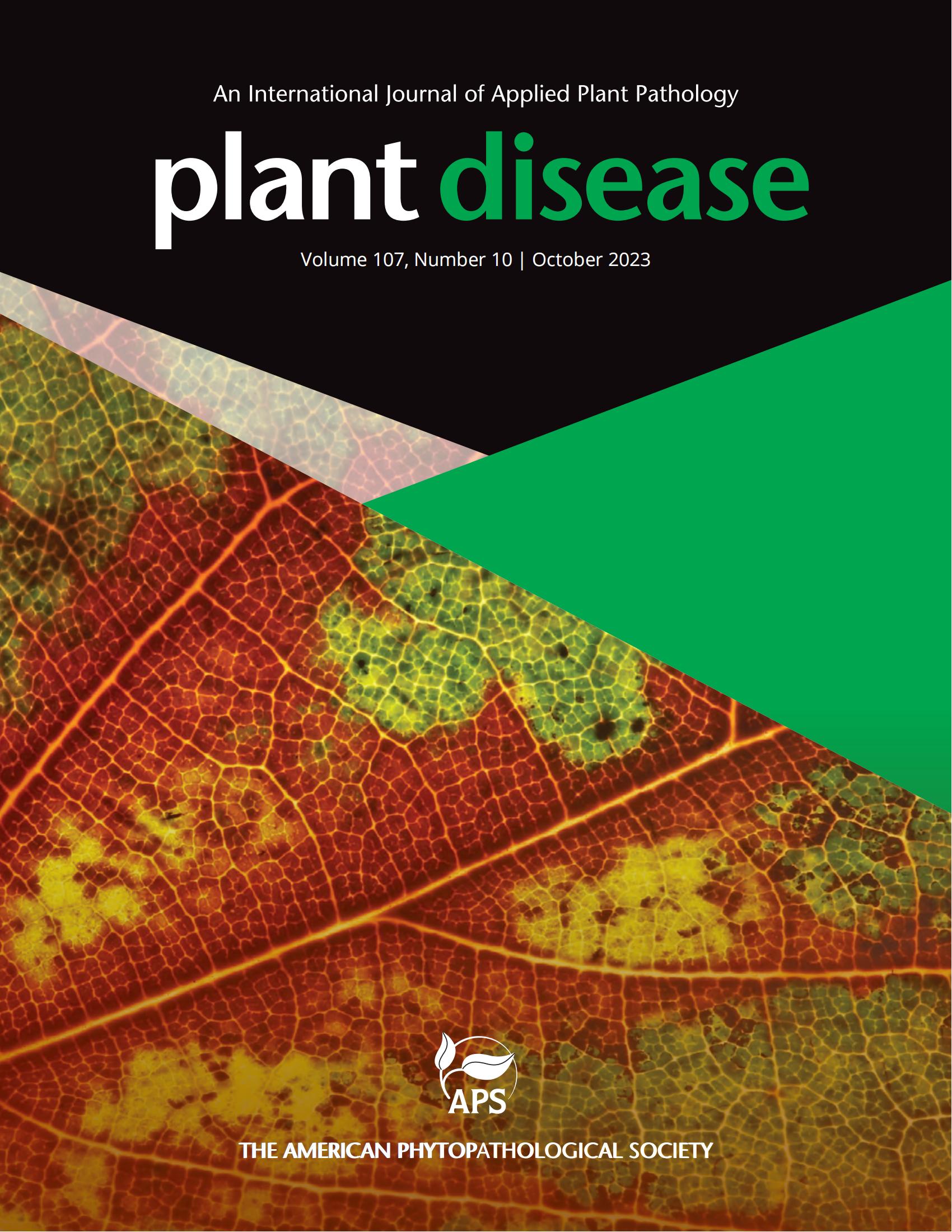中国河南首次报告由 Agroathelia rolfsii 引起的 Epimedium sagittatum 南方枯萎病。
摘要
淫羊藿[Epimedium sagittatum (Sieb. et Zucc.) Maxim.、E. brevicornu Maxim.、E. pubescens Maxim.、E. koreanum Nakai]为多年生草本植物,干叶用于中药,具有不同的药效(《中国药典》2020年版)。2022 年 8 月上旬(平均最高气温 33 ℃,最低气温 25 ℃,相对湿度 70% 以上),在中国河南省邓州市(北纬 32°35'26.84",东经 112°11'8.37")的一年生和二年生矢车菊植株上首次观察到大面积坏死叶斑。沿叶柄观察到白色菌丝体、黄色和褐色的菌核,并在叶片背面和病株周围的土壤-叶柄界面上定植。白色菌丝体以病株为中心迅速向邻近植株扩散,受感染的植株最终枯萎。在河南邓州和湖北丹江口调查的种植田中,病害发生率分别为 16.0% 和 28.0%,导致减产 20% 以上。将有症状的组织(叶柄,n≥10)用高压灭菌剪刀剪成 0.5 cm 的小段,用 75% 的乙醇进行表面灭菌 30 s,然后在 1% 的 NaClO 中灭菌 3 min,用蒸馏无菌水冲洗 3 次,在生物层流罩中用高压灭菌滤纸去除多余水分,移至马铃薯葡萄糖琼脂(PDA)平板上,在 28℃培养箱中黑暗培养 3-5 天。获得了 12 个具有白色辐射状菌落形态的真菌分离物,并通过吸头法进行了纯化。这些分离物形成的放射状菌落显示出丰富的气生菌丝,生长速度为 19.25 至 22.25 毫米/天(平均 = 21.67 ± 0.77 毫米;n = 36),接种后在 28℃下培养 5-7 天后观察到丰富的白色硬菌丝。分离物的菌丝呈透明状,分枝,隔膜处有夹子连接。培养 10-14 天后,分离物在 PDA 平板上形成深褐色的硬菌。成熟的棕色硬菌直径为 1.31 至 3.07 毫米(平均值 = 1.91 ± 0.39 毫米;n = 40),在每个培养皿中观察到 13 至 45 个硬菌(平均值 = 28;n = 24)。根据形态特征,初步确定分离物为 Agroathelia rolfsii(Yi Y. 等,2024 年),并选择分离物 YYHBJ1 作为代表分离物进行分子鉴定和致病性试验。用 CTAB 法提取基因组 DNA。为进行分子鉴定,扩增了 ITS 区、翻译延伸因子-1α(TEF-1α)和核大亚基核糖体 DNA(nLSU-rDNA)(White 等,1990 年;Wendland 和 Kothe,1997 年)。分离株 YYHBJ1 的 684-bp ITS(OR428367)、534-bp TEF1α (OR485567)和 965-bp nLSU-rDNA (OR426612)序列已存入 GenBank。序列分析表明,YYHBJ001的ITS、TEF1α和nLSU-rDNA序列与Agroathelia rolfsii (Sacc.) Redhead & Mullineux(Redhead and Mullineux 2023)的ITS(MN380242 and JF819727)、EF1α(MN262527)和nLSU-rDNA(MT225781 and AY635773)序列的同一性分别为100%、99.63%和100%。致病性试验是通过接种生长在无菌土壤花盆中的 1 年生 E. sagittatum 植物来确认的。将带有 3 个棕色硬孢菌的 PDA 塞(直径 5 毫米)和培养 12 天的真菌培养物放在土壤表面的叶柄旁。对照植株接种的是不含病原体的 PDA 插条。每种处理使用 5 株植物。植物在 28℃、相对湿度为 80% 的培养箱中培养。14 天后,白色菌丝从菌丝体中长出,并沿着叶柄蔓延到叶片,受感染的叶片呈黄色。21 至 24 天后,所有接种的植物都出现了田间观察到的症状,而对照组则没有症状。如上所述,从接种植物中重新分离出真菌,符合科赫假说。致病性试验重复了三次。根据形态特征和 DNA 序列,确定 Epimedium 植物上南方枯萎病的病原体为 A. rolfsii(拟态 S. rolfsii)。病原菌A. rolfsii通常侵染多种作物并引起南方枯萎病,如花生、辣椒、葱等(Daunde et al. 2018)。据我们所知,这是中国河南首次报道 A. rolfsii 在矢车菊植株上引起南枯病。Epimedium [Epimedium sagittatum (Sieb. et Zucc.) Maxim., E. brevicornu Maxim., E. pubescens Maxim., E. koreanum Nakai] plants are perennial herbs and the dry leaves were used in traditional Chinese medicine with different medicinal effects (Chinese Pharmacopoeia, 2020 edition). In early August 2022 (the high temperature was 33 ℃ and the low temperature was 25 ℃ on average with above 70% relative humidity), large necrotized leaf spots were initially observed in one-year and two-year old E. sagittatum plants in Dengzhou (32°35'26.84" N, 112°11'8.37" E), Henan province, China. White mycelia, yellow and brown sclerotia were observed along the petioles and colonized to the back of leaves and also on soil-petioles interface around the diseased Epimedium plants. White mycelia spread rapidly from the disease plants as a center to neighboring plants and the infected plants eventually wilted. The disease incidence was 16.0% and 28.0% in the surveyed cultivation fields in Dengzhou (Henan) and Danjiangkou (Hubei), respectively, which resulted in above 20% of yield loss. The symptomatic tissues (petioles, n≥10) were cut into 0.5 cm sections with autoclaved scissors and surface sterilized with 75% ethanol for 30 s, followed by 3 min in 1% NaClO, rinsed three times with distilled sterile water, plated on autoclaved filter paper to remove excess moisture in a biological laminar hood, transferred onto potato dextrose agar (PDA) plates and incubated at 28℃ in incubator in the dark for 3-5 days. Twelve fungal isolates with white radial colony morphology were obtained and purified by hyphal-tip method. The isolates formed radial colonies showing abundant aerial mycelia with a growth rate of 19.25 to 22.25 mm/day (mean = 21.67 ± 0.77 mm; n = 36) and white abundant sclerotia were observed after 5-7 days post inoculation at 28℃. The hyphae of the isolates were hyaline, branched with clamp connections at septa. The isolates formed dark brown sclerotia on PDA plate post 10-14 days incubation. The diameter of mature brown sclerotia ranged from 1.31 to 3.07 mm (mean = 1.91 ± 0.39 mm; n = 40) and 13 to 45 sclerotia (mean = 28; n = 24) were observed on each Petri dish. The isolates were tentatively identified as Agroathelia rolfsii based on morphological characteristics (Yi Y., et al. 2024) and isolate YYHBJ1 was selected as representative isolate for molecular identification and pathogenicity test. The genomic DNA was extracted using CTAB method. For molecular identification, ITS region, translation elongation factor-1alpha (TEF-1α) and nuclear large-subunit ribosomal DNA (nLSU-rDNA) were amplified (White et al. 1990, Wendland and Kothe, 1997). The sequences 684-bp ITS (OR428367), 534-bp TEF1α (OR485567), and 965-bp nLSU-rDNA (OR426612) of isolate YYHBJ1 were deposited in GenBank. Sequence analysis revealed that ITS, TEF1α and nLSU-rDNA sequences of YYHBJ001 showed 100%, 99.63%, and 100% identity to ITS (MN380242 and JF819727), EF1α (MN262527) and nLSU-rDNA (MT225781 and AY635773) sequences of Agroathelia rolfsii (Sacc.) Redhead & Mullineux (Redhead and Mullineux 2023). Pathogenicity tests was confirmed by inoculating 1 year-old E. sagittatum plants grown in pots with sterile soil. PDA plug (5 mm diameter) colonized with 3 brown sclerotia and the fungal culture which was cultivated for 12 days was deposited beside the petiole on the surface of the soil. The control plants were inoculated with PDA plugs without the pathogen. Five plants were used in each treatment. The plants were cultivated in incubator at 28℃ with 80% relative humidity. Fourteen days later, white mycelia growing out from the sclerotia and spread along the petioles to the leave and the infected leaves were yellow. After 21 to 24 days, all inoculated plants displayed symptoms like those observed in field, while no symptoms were observed on the controls. The fungus was re-isolated from the inoculated plants as described above, fulfilling Koch's postulates. The pathogenicity tests were repeated three times. Based on morphological feature and DNA sequences, the pathogen of southern blight on Epimedium plants was identified as A. rolfsii (anamorph S. rolfsii). The pathogen A. rolfsii usually infect kinds of crops and cause southern blight, such as peanuts, chili peppers, green onion and so on (Daunde et al. 2018). To our knowledge, this is the first report of A. rolfsii causing southern blight on E. sagittatum plants in Henan in China.

 求助内容:
求助内容: 应助结果提醒方式:
应助结果提醒方式:


